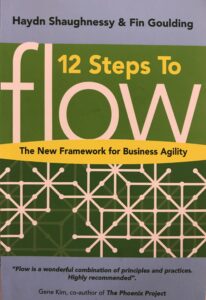Podcast: Play in new window | Download
Subscribe: RSS
Today’s podcast covers Chapter 2, “The Customer in the Agile Business” of “12 Steps to Flow: The New Framework for  Business Agility,” by Haydn Shaughnessy and Fin Goulding, developers of the internationally acclaimed workshop, Flow Academy. From my perspective, this chapter is all about the need for complex adaptive systems pulling in information and responding in a real-time manner responding to customer needs. See what you think.
Business Agility,” by Haydn Shaughnessy and Fin Goulding, developers of the internationally acclaimed workshop, Flow Academy. From my perspective, this chapter is all about the need for complex adaptive systems pulling in information and responding in a real-time manner responding to customer needs. See what you think.
- Key points from chapter 1 are brought forward:
- matrix innovation
- critical non-essentials and marginal gains
- value-seeking culture
- Flow Value Stack
For more on the Introduction and Chapter 1 go to episode 0037 of Wrestling with Chaos.
The concept CATE is introduced here, in Chapter 2
C = (dynamic) Customer segmentation
A = Asset discovery
T = Targeted ideation
E = Ecosystem
Customer segmentation reveals potential new markets, especially out at the long-tail where new trends are emerging. This requires the ability to innovate and adapt to the new trends on the fly — matrix innovation. Things can keep on changing out on that long tail.
A fascinating example given is creating financial markets for the poor (people outside established banking norms) in Africa via working with NGOs.
Asset discovery addresses what all is needed to satisfy demands in those newly-discovered markets. Do you use existing internal assets? Develop new assets? Utilize customers existing assets? Bring in partners? This is a very rich phase which requires a very direct discovery conversation within the team as well as bringing in the customers (more on that later) and/or potential partners. A conversation flow is established and maintained.
Targeted ideation essential flows from the asset discovery in terms of defining the products generated during customer segmentation.
Ecosystem comprises the context, the “geography,” so to speak of how and where the product(s) fit in the stakeholder landscape.
Economies of scope are discussed which is all about understanding directly customers needs. Rather than abstractions via big data or avatars it is better to gather information directly from, say, social media analysis. This allows for simultaneous differentiation of multiple products/services customer segments may need.
The recommend using social media tools such as StatSocial, Sprinklr, and Crimson Hexagon.
An example is given of a car dealership finding out a high percentage of purchasers were interested in biking. Consequently, they aligned the dealership with adjacent biking products.
An example of the Asset discovery, Targeted ideation, and Ecosystem coming together via the NGOs is a large, global retailer providing the transportation chain needed for land-rich, cash-poor, transportation-deprived farmers in Africa to get their product to richer markets.
Essentially, this is about developing complex adaptive systems that morph with discovers in and changes to the business environment.
In terms of methodologies the authors focus on visual processes…building “walls with post-its.” In other words, no lengthy documents. The team is vital and works as a unit real-time, face-to-face, generating the minimal amount of documentation needed, i.e., organized post-its. The process is very immediate. No lag time. evolving and innovating as they work to stay connected to customers and create solutions for customer needs. For more on the various “Walls” refer to their excellent book, “Flow.”
In line with Business Agility and dealing with complex situations, you can download CMC’s free e-book MINDSET – 5 SIMPLE WAYS TO LOOK AT COMPLEX PROBLEMS and learn how to find a simple vantage point from which you can resolve challenges.
Your feedback is important. Choose from the following options:
- place a review in iTunes,
- click on “leave a comment” below,
- send any comments along with your name and the show number to support@ctrchg.com
Listen to future episodes for our reply.


Recent Comments